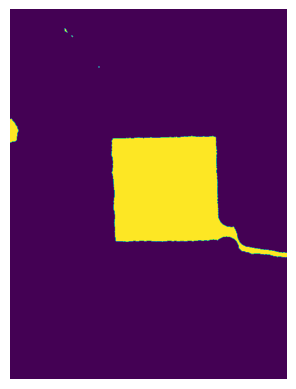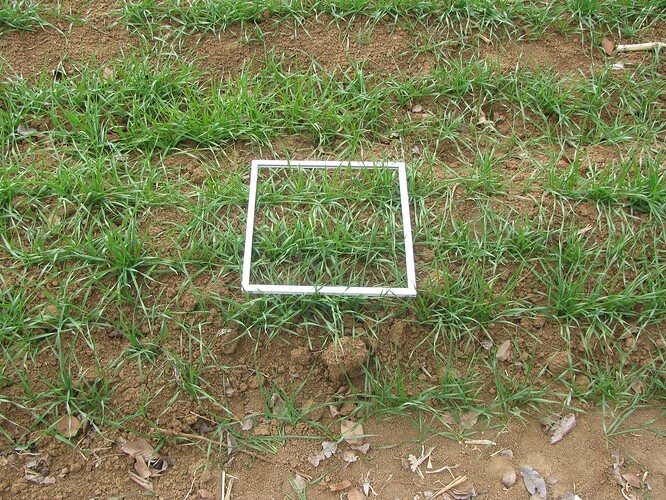Thank you for your consideration. The context is the multidisciplinary and newly emerged area of “Modern crop phenotyping”. Among the subfields of this area are “image-based phenotyping” and “ground-based imaging”, which aims to determine the phenotype (or visible status) of crop canopies (or plants) more rapidly, efficiently, precisely, and also quantitatively.
The purpose of the present project (our project) is to evaluate the effect of several variables (i.e. sensor/camera, height, and imaging time) on the output of the recently introduced model of GSM (green-gradient based canopy segmentation model), which provides a new definition of green canopy based on the shading patterns. Of course, as many other measurements in crop science, sampling is a basic and important practice, which is carried out here, using a white framework (quadrat); particularly if the canopy is not uniform, or parts of other unwanted experimental plots have been taken in the image.
Here, I have several hundred images, which should be pre-processed (i.e. cropped) before used as the inputs of GSM model.
Currently, the archive is not public, but I can send you some more images. Moreover, there are public archives of various crop species available on the internet.
In general, modern crop phenotyping faces various topics and questions to be addressed using image processing. In this context, you can find many studies, codes, and tools on processing of ground based images of experimental plots grown in the field, 3D reconstruction of single plant, plant root system 3D reconstruction (mostly using CT-scan or MRI images) and respective measurements, seed and grain processing, etc. However, compared with the potential of contribution of the data stored in the images, it seems that there is still more work to be done in image processing techniques for modern crop phenotyping.
Obviously, as a researcher in crop science, I prefer to use ready tools; however, they are not available enough and I should write my own codes as a beginner in image processing and coding. Considering the relative novelty of this field, even very simple codes and tools of image processing may lead to considerable findings and achievements in crop science and plant breeding. Only for instance, you can find such simplicity and applications in our publications:
Haghshenas, A., & Emam, Y. (2019). Image-based tracking of ripening in wheat cultivar mixtures: A quantifying approach parallel to the conventional phenology. Computers and Electronics in Agriculture, 156, 318-333.
Haghshenas, A., & Emam, Y. (2019). Evidence for relative grain yield simulation by red color level of beneath-canopy soil at wheat booting phase: An unexpected observation using image processing. Computers and Electronics in Agriculture, 162, 1028-1034. doi:https:/ /doi.org/10.1016/j.compag.2019.05.044
Haghshenas, A., & Emam, Y. (2020). Green-gradient based canopy segmentation: A multipurpose image mining model with potential use in crop phenotyping and canopy studies. Computers and Electronics in Agriculture, 178, 105740. doi:https:/ /doi.org/10.1016/j.compag.2020.105740
Haghshenas, A., Emam, Y., Sepaskhah, A. R., & Edalat, M. (2021). Can extended phenology in wheat cultivar mixtures mitigate post-anthesis water stress? European Journal of Agronomy, 122, 126188. doi:https:/ /doi.org/10.1016/j.eja.2020.126188
Haghshenas, A., Emam, Y., & Jafarizadeh, S. (2022). Wheat grain width: a clue for re-exploring visual indicators of grain weight. Plant Methods, 18(1), 58. https:/ /doi.org/10.1186/s13007-022-00891-1
Haghshenas, A., & Emam, Y. (2022). Accelerating leaf area measurement using a volumetric approach. Plant Methods, 18(1), 61. https:/ /doi.org/10.1186/s13007-022-00896-w
- Codes and computational capsules:
Haghshenas, A., Emam, Y., Jafarizadeh, S., (2019) Canopy CCGR (a code for: Image-based tracking of ripening in wheat cultivar mixtures: a quantifying approach parallel to the conventional phenology) [Source Code]. https:/ /doi.org/10.24433/CO.e54ee03b-bb49-4cba-a707-bcac33c13743.v2
Haghshenas, A., Emam, Y., Jafarizadeh, S., (2020) Canopy GSM [Source Code]. https:/ /doi.org/10.24433/CO.4355649.v2
Haghshenas, A. (2022). Visual Grain Analyzer (Version 1.0.1). [Computer software]. https:/ /github.com/haqueshenas/Visual-Grain-Analyzer
Haghshenas, A. (2022). Optical Leaf Area (Version 1.0.0). [Computer software]. https:/ /doi.org/10.5281/zenodo.6462380












